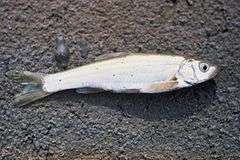Virgin spinedace
| Virgin spinedace | |
|---|---|
 | |
| Scientific classification | |
| Kingdom: | Animalia |
| Phylum: | Chordata |
| Class: | Actinopterygii |
| Order: | Cypriniformes |
| Family: | Cyprinidae |
| Genus: | Lepidomeda |
| Species: | L. mollispinis |
| Binomial name | |
| Lepidomeda mollispinis R. R. Miller & C. L. Hubbs, 1960 | |
The Virgin spinedace or Virgin River spinedace, Lepidomeda mollispinus, is a cyprinid fish of the Virgin River, a tributary of the Colorado River in the United States.
This spinedace is overall silvery in color, with a brassy sheen and a pattern of sooty blotches or speckles on each side. The dorsal fin has eight rays, the first two of which are spiny, the second being longer than the one closer to the frontal area.[1] The anal fin has eight to 10 rays, usually 9. The breeding male is more brightly colored, developing a band on the anal fin, orange to red shades on the paired fins, and a spot of red or gold color at the top of the gill slit. The Virgin spinedace adult is generally 6 to 12 cm in total length.[2] The mouth is less oblique than that of L. vittata. The dorsal fin is lower and rounded, and its depressed length is 5.6 to 6.1 cm.[3] The Virgin Spinedace is omnivorous, with a diet of primarily aquatic insects.[4]
The Virgin spinedace habitat is clear water about 1 m (3 ft) deep, preferably close to cover, such as overhanging shrubs or banks, near vegetation, and over sand or gravel. The fish prefers slow water in areas that do not experience heavy flooding. The fish can tolerate water temperatures of 29°C (85°F) or higher, a useful ability in the summer when the river becomes intermittent and the fish must crowd into isolated pools.[1] They prefer clear, cool, relatively swift streams with scattered pools,[3] and often will use shear zones between low and high current velocities.[5]
Range
Populations are known at various locations in the Virgin River system, including the North Fork and East Fork of the Virgin River in Zion National Park, the Santa Clara River, Beaver Dam Creek, and Ash Creek. Although the species has a very restricted range, most of the critical habitat has been protected under a conservation agreement, and it is not listed as endangered.[6]
The Virgin spinedance is also found in Mohave County, Arizona, in the lower Beaver Dam Wash to its confluence with the Virgin River at Littlefield. They are historically present in the Virgin River from the Utah border to Littlefield, primarily in conjunction with clear water inflows of perennial tributaries.[5]
Population trends
The Virgin spinedace has completely disappeared from 37% of postulated historic habitat in the Virgin River. Decreases in habitat occupied in major tributaries vary between 31% and 100%. As of 1995, the Virgin spinedace were last officially observed by Bureau of Land Management personnel in 1991, where the remaining fish were caught and deposited at the Arizona State University Museum.[7]
Management factors
The major factors affecting Virgin spinedace are water diversion, impoundment, channelization, degradation of water quality, and introduced species, both fishes and crayfish. Two specific problems are competition with Richardsonius hydrophlox and predation by brown trout (S. trutta).[3]
Management emphasizes implementation of the Virgin River Spinedace Conservation Agreement, which calls for the protection and enhancement of the Virgin River water quantity and quality as well as seeks to limit the effects of nonnative fish species in Spinedace waters, and also aims to re-establish additional populations in the Virgin Spinedace historical habitat.
Notes
- 1 2 Froese, Rainer and Pauly, Daniel, eds. (2006). "Lepidomeda mollispinis" in FishBase. October 2006 version.
- ↑ Rinne, W.E. 1971. The life history of Lepidomeda mollispinis mollispinis (the Virgin River spinedace) a unique western cyprinid. M.S. thesis, Univ. Nevada Las Vegas. pp. 109.
- 1 2 3 Minckley, W.L. 1973. Fishes of Arizona. Arizona Game and Fish Department, Phoenix, AZ. pp. 111-113
- ↑ William F. Sigler and John W. Sigler, Fishes of Utah (University of Utah Press, 1996), pp. 93-96.
- 1 2 http://www.azgfd.gov/w_c/edits/documents/Lepimomo.fo_000.pdf
- ↑ 1996 FWS press release on conservation agreement
- ↑ Arizona Game and Fish Department Native Fish Diversity Review. 1995. Tempe, Arizona.
References
- William F. Sigler and John W. Sigler, Fishes of Utah (University of Utah Press, 1996), pp. 93–96
- Details of Utah conservation plan (PDF)
